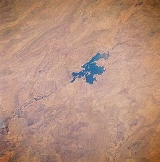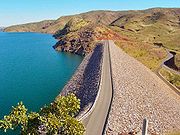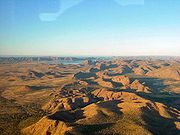
Lake Argyle
Encyclopedia
Lake Argyle is Australia
's second largest artificial lake
by volume. It is part of the Ord River Irrigation Scheme and is located near the East Kimberley (Western Australia
) town of Kununurra. The lake flooded large parts of the Shire of Wyndham-East Kimberley on the Kimberley Plateau about eighty kilometres inland from the Joseph Bonaparte Gulf
, close to the border with the Northern Territory
.
The primary inflow is the Ord River
, while the Bow River
and many other smaller creeks also flow into the dam.
The lake is a DIWA-listed wetland
. as it is the largest lake in northern Australia and an excellent example of a man-made lake. Additionally Lake Argyle, along with Lake Kununurra
, are recognised as a Ramsar
protected wetlands and were listed in 1990 as Australian Site Number 32.
In 1996, the spillway wall was raised by 6 metres, which doubled the dams capacity. Sediment
flowing into the dam caused concerns in the mid 1990s that the dam's capacity could be dramatically reduced. By 2006 continual regeneration of the upper Ord catchment appeared to have reduced the amount of sediment inflow.
 Lake Argyle normally has a surface area of about 1,000 square kilometres. The storage capacity, to the top of the spillway is 10,763,000 megalitres. The lake filled to capacity in 1973, and the spillway flowed until 1984. Lake Argyle's usual storage volume is 5,797,000 megalitres, making it the second largest reservoir in Australia (the combined Lake Gordon
Lake Argyle normally has a surface area of about 1,000 square kilometres. The storage capacity, to the top of the spillway is 10,763,000 megalitres. The lake filled to capacity in 1973, and the spillway flowed until 1984. Lake Argyle's usual storage volume is 5,797,000 megalitres, making it the second largest reservoir in Australia (the combined Lake Gordon
/Lake Pedder
in Tasmania
is the largest.) At maximum flood level, the lake would hold 35 million megalitres of water and cover a surface area of 2,072 square kilometres.
 Lake Argyle, together with Lake Kununurra
Lake Argyle, together with Lake Kununurra
, is part of the Ord River Irrigation Scheme. There are currently some 150 square kilometres of farmland under irrigation in the East Kimberly region. The original plan was for dam water to irrigate rice
crop for export to China. However these plans were scuttled as waterfowl, particularly magpie geese ate rice shoots quicker than they could be planted. Other crops are now grown, but Lake Argyle still remains Australia's most under-utilized lake.
; with Lake Kununurra it forms the Lakes Argyle and Kununurra Ramsar Site
.
The lake is now home to 26 species of native fish and a population of freshwater crocodile
s currently estimated at some 25,000. Fish species that are present in Lake Argyle include barramundi
, southern saratoga
, archer fish, forktail cat fish, mouth almighty, long tom
, bony bream
and sleepy cod
. While the official website states that only incidentally a saltwater crocodile
is found, other experts disagree.
Cane toads reached the dam in late 2008, mostly via traveling along the Victoria Highway
, with numbers rising significantly during the 2009 summer.
s and grassland
s, has been identified by BirdLife International
as an Important Bird Area
(IBA) because it supports about 150,000 waterbirds. Birds for which the lake has global importance include Magpie Geese, Wandering Whistling-ducks, Green Pygmy-geese, Pacific Black Duck
s, Hardhead
s, Black-necked Stork
s, Australian Bustard
s, White-headed Stilt
s, Red-capped Plover
s, Oriental Plover
s, Black-fronted Dotterel
s, Long-toed Stint
s and Sharp-tailed Sandpiper
s.
Australia
Australia , officially the Commonwealth of Australia, is a country in the Southern Hemisphere comprising the mainland of the Australian continent, the island of Tasmania, and numerous smaller islands in the Indian and Pacific Oceans. It is the world's sixth-largest country by total area...
's second largest artificial lake
Lake
A lake is a body of relatively still fresh or salt water of considerable size, localized in a basin, that is surrounded by land. Lakes are inland and not part of the ocean and therefore are distinct from lagoons, and are larger and deeper than ponds. Lakes can be contrasted with rivers or streams,...
by volume. It is part of the Ord River Irrigation Scheme and is located near the East Kimberley (Western Australia
Western Australia
Western Australia is a state of Australia, occupying the entire western third of the Australian continent. It is bounded by the Indian Ocean to the north and west, the Great Australian Bight and Indian Ocean to the south, the Northern Territory to the north-east and South Australia to the south-east...
) town of Kununurra. The lake flooded large parts of the Shire of Wyndham-East Kimberley on the Kimberley Plateau about eighty kilometres inland from the Joseph Bonaparte Gulf
Joseph Bonaparte Gulf
Joseph Bonaparte Gulf is a large body of water off the coast of the Northern Territory, Australia and Western Australia. It was named after Joseph Bonaparte, brother of Napoleon and King of Naples and then Spain by French explorer and naturalist Nicholas Baudin in 1803...
, close to the border with the Northern Territory
Northern Territory
The Northern Territory is a federal territory of Australia, occupying much of the centre of the mainland continent, as well as the central northern regions...
.
The primary inflow is the Ord River
Ord River
The Ord River is a 320-kilometre-long river in the Kimberley region of Western Australia. It was named in honour of Harry Ord, Governor of Western Australia from 1877 to 1880....
, while the Bow River
Bow River (Kimberley region, Western Australia)
Bow River is a 148 km long tributary of the Ord River in the Kimberley region of northern Western Australia. The river was named by pastoralist Michael Durack in 1882 after a river in his homeland of County Galway, Ireland....
and many other smaller creeks also flow into the dam.
The lake is a DIWA-listed wetland
A Directory of Important Wetlands in Australia
A Directory of Important Wetlands in Australia is a list of wetlands of national importance to Australia. Intended to augment the list of wetlands of international importance under the Ramsar Convention, it was formerly published in report form, but is now essentially an online publication...
. as it is the largest lake in northern Australia and an excellent example of a man-made lake. Additionally Lake Argyle, along with Lake Kununurra
Lake Kununurra
Lake Kununurra is a long linear lake in the Ord River valley formed in 1963 by the construction of the Ord Diversion Dam in Kununurra, northern Western Australia, which was built to supply water to the Ord River Irrigation Area. The lake stretches for upstream from the Diversion Dam at towards...
, are recognised as a Ramsar
Ramsar Convention
The Ramsar Convention is an international treaty for the conservation and sustainable utilization of wetlands, i.e., to stem the progressive encroachment on and loss of wetlands now and in the future, recognizing the fundamental ecological functions of wetlands and their economic, cultural,...
protected wetlands and were listed in 1990 as Australian Site Number 32.
History and construction
The construction of the Ord River Dam was completed in 1971 by the American Dravo Corporation. The dam was officially opened the following year. The dam is 335 metres long, and 98 metres high. The earth-fill only dam wall at Lake Argyle is the most efficient dam in Australia in terms of the ratio of the size of the dam wall to the amount of water stored. The lake was named after the property it partly submerged, Argyle Downs.In 1996, the spillway wall was raised by 6 metres, which doubled the dams capacity. Sediment
Sediment
Sediment is naturally occurring material that is broken down by processes of weathering and erosion, and is subsequently transported by the action of fluids such as wind, water, or ice, and/or by the force of gravity acting on the particle itself....
flowing into the dam caused concerns in the mid 1990s that the dam's capacity could be dramatically reduced. By 2006 continual regeneration of the upper Ord catchment appeared to have reduced the amount of sediment inflow.
Water supply

Lake Gordon
Lake Gordon is a reservoir created by the Gordon Dam on the upper reaches of the Gordon River in south-west Tasmania, Australia. The reservoir was formed in the early 1970s as a result of the dam construction by the HEC...
/Lake Pedder
Lake Pedder
Lake Pedder was once a natural lake, located in the southwest of Tasmania, Australia but the name is now used in an official sense to refer to the much larger artificial impoundment and diversion lake formed when the original lake was expanded by damming in 1972 by the Hydro Electric Commission of...
in Tasmania
Tasmania
Tasmania is an Australian island and state. It is south of the continent, separated by Bass Strait. The state includes the island of Tasmania—the 26th largest island in the world—and the surrounding islands. The state has a population of 507,626 , of whom almost half reside in the greater Hobart...
is the largest.) At maximum flood level, the lake would hold 35 million megalitres of water and cover a surface area of 2,072 square kilometres.

Lake Kununurra
Lake Kununurra is a long linear lake in the Ord River valley formed in 1963 by the construction of the Ord Diversion Dam in Kununurra, northern Western Australia, which was built to supply water to the Ord River Irrigation Area. The lake stretches for upstream from the Diversion Dam at towards...
, is part of the Ord River Irrigation Scheme. There are currently some 150 square kilometres of farmland under irrigation in the East Kimberly region. The original plan was for dam water to irrigate rice
Rice
Rice is the seed of the monocot plants Oryza sativa or Oryza glaberrima . As a cereal grain, it is the most important staple food for a large part of the world's human population, especially in East Asia, Southeast Asia, South Asia, the Middle East, and the West Indies...
crop for export to China. However these plans were scuttled as waterfowl, particularly magpie geese ate rice shoots quicker than they could be planted. Other crops are now grown, but Lake Argyle still remains Australia's most under-utilized lake.
Flora and fauna
The damming of the Ord River has caused major changes to the environment. Flows to the Ord River have been severely reduced. Within Lake Argyle itself a thriving new eco-system has developed. The lake is recognised as an important wetland area under the Ramsar ConventionRamsar Convention
The Ramsar Convention is an international treaty for the conservation and sustainable utilization of wetlands, i.e., to stem the progressive encroachment on and loss of wetlands now and in the future, recognizing the fundamental ecological functions of wetlands and their economic, cultural,...
; with Lake Kununurra it forms the Lakes Argyle and Kununurra Ramsar Site
Lakes Argyle and Kununurra Ramsar Site
The Lakes Argyle and Kununurra Ramsar Site comprises an extensive system of artificial freshwater reservoirs, with their associated permanent wetlands, formed by damming the Ord River in the eastern part of the Kimberley Region of northern Western Australia. The reservoirs include Lake Argyle and...
.
The lake is now home to 26 species of native fish and a population of freshwater crocodile
Freshwater Crocodile
The freshwater crocodile , also known as the Australian freshwater crocodile, Johnston's crocodile or colloquially as freshie, is a species of reptile endemic to the northern regions of Australia...
s currently estimated at some 25,000. Fish species that are present in Lake Argyle include barramundi
Barramundi
The Barramundi , also known as Asian Seabass, is a species of catadromous fish in family Latidae of order Perciformes. The native species is widely distributed in the Indo-West Pacific region from the Persian Gulf, through Southeast Asia to Papua New Guinea and Northern Australia. Known in Thai...
, southern saratoga
Southern saratoga
The southern saratoga is a species of fish in the Osteoglossidae family. It is endemic to Australia.-Description:...
, archer fish, forktail cat fish, mouth almighty, long tom
Long Tom
Long Tom may refer to:* the Long Tom River in Oregon* Long Tom Pass, a mountain pass in Mpumalanga, South Africa* Long Tom , an Australian sounding rocket* Long Tom, a chimney pot approximately 4 to 6 feet tall...
, bony bream
Bony bream
Bony bream Nematalosa erebi are a widespread and common, small to medium sized Australian freshwater fish often found in large shoals throughout much of northern and central Australia, and the Murray-Darling basin.-Description:...
and sleepy cod
Sleepy cod
The sleepy cod, Oxyeleotris lineolatus, is a medium-sized freshwater fish, native to tropical regions of northern Australia.Sleepy cod generally weigh up to 3 kg. They are very common in waterways across northern Australia. They are plain brown coloured fishes. They are sedentary in nature...
. While the official website states that only incidentally a saltwater crocodile
Saltwater Crocodile
The saltwater crocodile, also known as estuarine or Indo-Pacific crocodile, is the largest of all living reptiles...
is found, other experts disagree.
Cane toads reached the dam in late 2008, mostly via traveling along the Victoria Highway
Victoria Highway
The Victoria Highway is a 524 kilometre highway linking the Great Northern Highway in Western Australia with the Stuart Highway in the Northern Territory. It is a part of the Perth - Darwin National Highway link. It is signed as National Highway 1 and is also a part of the Highway 1 network. It is...
, with numbers rising significantly during the 2009 summer.
Birds
The lake, with its surrounding mudflatMudflat
Mudflats or mud flats, also known as tidal flats, are coastal wetlands that form when mud is deposited by tides or rivers. They are found in sheltered areas such as bays, bayous, lagoons, and estuaries. Mudflats may be viewed geologically as exposed layers of bay mud, resulting from deposition of...
s and grassland
Grassland
Grasslands are areas where the vegetation is dominated by grasses and other herbaceous plants . However, sedge and rush families can also be found. Grasslands occur naturally on all continents except Antarctica...
s, has been identified by BirdLife International
BirdLife International
BirdLife International is a global Partnership of conservation organisations that strives to conserve birds, their habitats and global biodiversity, working with people towards sustainability in the use of natural resources...
as an Important Bird Area
Important Bird Area
An Important Bird Area is an area recognized as being globally important habitat for the conservation of bird populations. Currently there are about 10,000 IBAs worldwide. The program was developed and sites are identified by BirdLife International...
(IBA) because it supports about 150,000 waterbirds. Birds for which the lake has global importance include Magpie Geese, Wandering Whistling-ducks, Green Pygmy-geese, Pacific Black Duck
Pacific Black Duck
The Pacific Black Duck is a dabbling duck found in much of Indonesia, New Guinea, Australia, New Zealand, and many islands in the southwestern Pacific, reaching to the Caroline Islands in the north and French Polynesia in the east. It is usually called the Grey Duck in New Zealand...
s, Hardhead
Hardhead
The Hardhead, Aythya australis, is the only true diving duck found in Australia. Hardheads are common in the south-east of Australia, particularly in the Murray-Darling Basin, but also in the wetter country near the coasts. They are moderately nomadic in normal years, but disperse widely in times...
s, Black-necked Stork
Black-necked Stork
The Black-necked Stork is a tall long-necked wading bird in the stork family. It is a resident species across South and Southeast Asia with a disjunct population in Australia. It lives in wetland habitats to forage for a wide range of animal prey...
s, Australian Bustard
Australian Bustard
The Australian Bustard, Ardeotis australis, is a large ground bird of grassland, woodland and open agricultural country across northern Australia and southern New Guinea. It is also commonly referred to in Central Australia as the Bush Turkey, particularly by Aboriginal people.The male is up to ...
s, White-headed Stilt
White-headed Stilt
The White-headed Stilt or Pied Stilt is a bird in the Recurvirostridae family. It is sometimes treated as a distinct species Himantopus leucocephalus, sometimes included in the Common or Black-winged Stilt as Himantopus himantopus leucocephalus.This shorebird is found in Australia, Brunei,...
s, Red-capped Plover
Red-capped Plover
The Red-capped Plover , also known as the Red-capped Dotterel, is a small plover. It breeds in Australia. The species is closely related to the Kentish Plover, Javan Plover and White-fronted Plover.-Description:Red-capped Plovers have white underparts and forehead...
s, Oriental Plover
Oriental Plover
The Oriental Plover, Charadrius veredus, also known as the Oriental Dotterel, is a medium-sized Charadriine plover closely related to the Caspian Plover.- Description :...
s, Black-fronted Dotterel
Black-fronted Dotterel
The Black-fronted Dotterel is a small, slender plover, widespread throughout most of Australia, to which it is native and New Zealand, where it self introduced in the 1950s. It is common in freshwater wetlands, around the edges of lakes and billabongs, and in shallow, temporary claypan pools...
s, Long-toed Stint
Long-toed Stint
The Long-toed Stint, Calidris or Erolia subminuta, is a small wader bird. It breeds across northern Asia and is strongly migratory, wintering in south and south east Asia and Australasia...
s and Sharp-tailed Sandpiper
Sharp-tailed Sandpiper
The Sharp-tailed Sandpiper, Calidris acuminata is a small wader.- Taxonomy :More recently, a review of new data has indicated that this bird should perhaps better be placed into the genus Philomachus- as P...
s.
See also
- List of lakes in Western Australia, A-C
- List of reservoirs and dams in Australia
- Water security in AustraliaWater security in AustraliaWater security in Australia has become a major concern over the course of the late 20th and early 21st century as a result of population growth, severe drought, fears of the effects of global warming on Australia, environmental degradation from reduced environmental flows, competition between...

